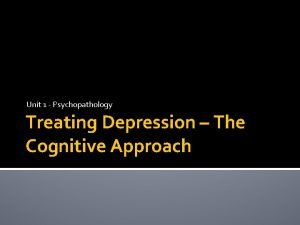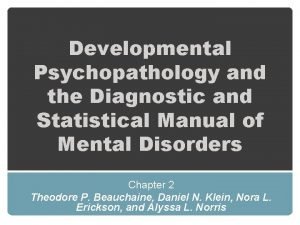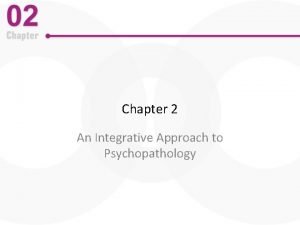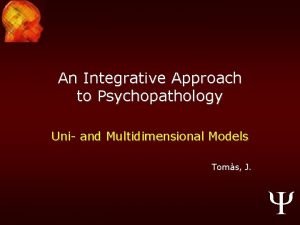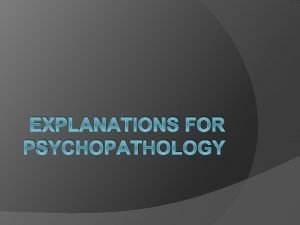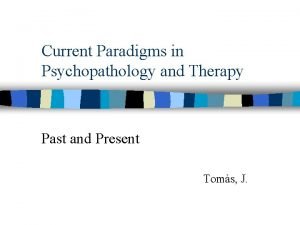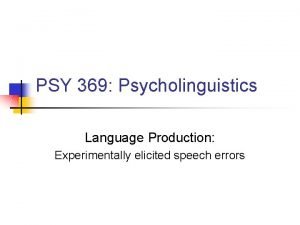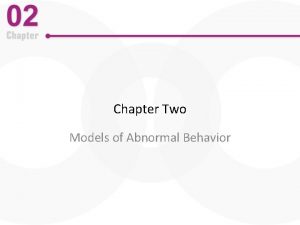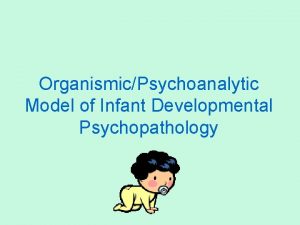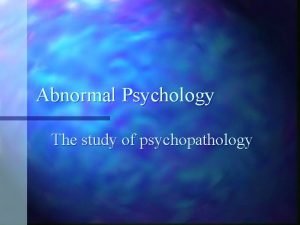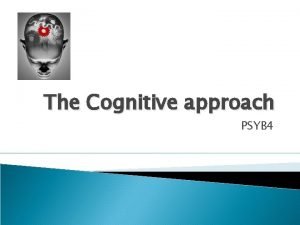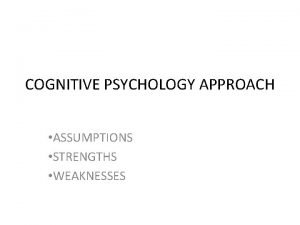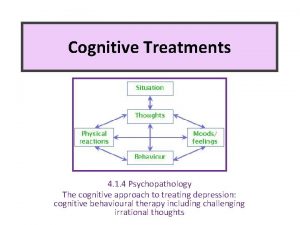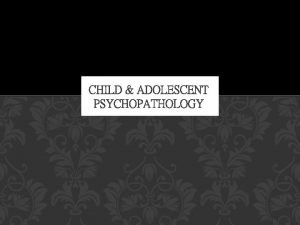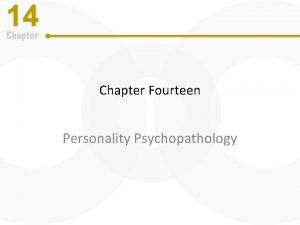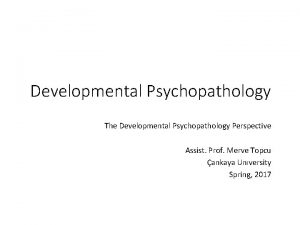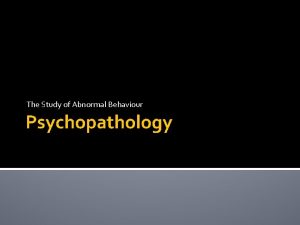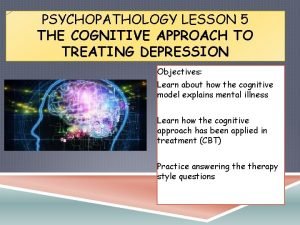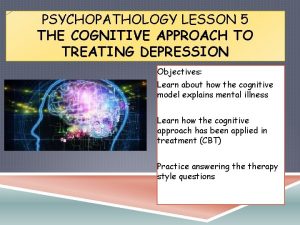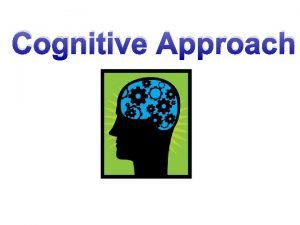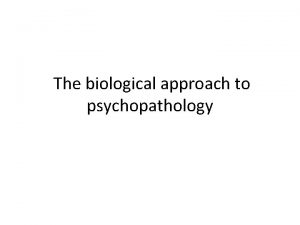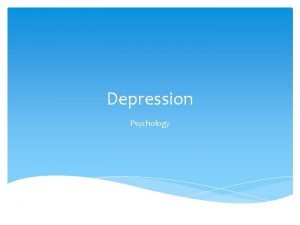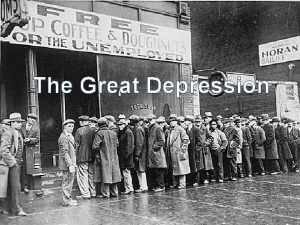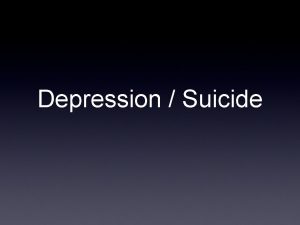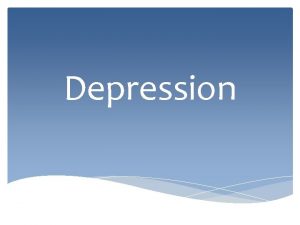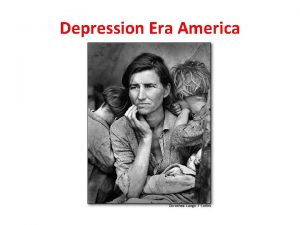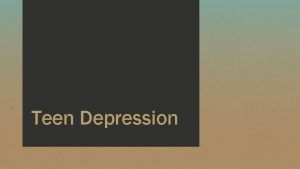THE COGNITIVE APPROACH TO DEPRESSION Psychopathology STARTER WHAT























- Slides: 23

THE COGNITIVE APPROACH TO DEPRESSION Psychopathology

STARTER – WHAT DO YOU KNOW? • Which definition of abnormality focuses on societal norms? • Identify three criteria for ideal mental health. • Maladaptiveness, unpredictability and observer discomfort are features of which definition? • Draw a normal distribution and identify the area which would signify abnormality according to statistical infrequency.

OBJECTIVES • To be able to outline the behavioural, emotional and cognitive characteristics of depression. • To be able to describe Beck’s cognitive triad and explain how this relates to depression. • Outline Ellis’ ABC approach to depression • To be able to describe cognitive distortions seen in depression

FACTS ABOUT DEPRESSION • The most common psychiatric condition in the UK • 1 in 10 people suffer from this disorder at any one time • 1 in 5 will suffer from this at some point in their lives • More common in women • Sixty percent of all suicides are related to mood disorders such as depression. • Treated with antidepressants and CBT

Task 1 Reading up to page 4 Task 2 Activity 1 – identify the emotional, cognitive and Behavioural characteristics of depression Compare the cognitive approach of depression to the biological and behavioural approach Neurotransmitters, operant conditioning, social learning theory, genes, drugs, conditioning, learning.

BASIC ASSUMPTIONS • Depression is caused by faulty thinking patterns. • This thinking affects an individuals behaviour. • People with depression have a negative self schema. • To treat depression you need to focus on changing the negative thoughts to more realistic thinking patterns. • Cognitive Behavioural Therapy is the most common type of cognitive therapy.

Beck’s Cognitive Triad

ALBERT ELLIS • Albert Ellis believed that depression was caused by unrealistic and over negative beliefs about events. • Events in the environment are processed in a negative way and this leads to behaviours that we see in depression. • This is known as the ABC approach. • A – activating event • B- beliefs about the event • C – emotional consequences (low mood, self criticism, withdrawal)

Albert Ellis – The ABC Approach

COGNITIVE DISTORTIONS • Overgeneralisations • Minimisation and magnification • Catastrophising • Mustabation

OUTLINE THE COGNITIVE APPROACH OF DEPRESSION (4) • Basic assumptions • Beck’s cognitive Triad • Ellis’ ABC approach

EXAMPLE ANSWER • The cognitive approach to depression suggests that depression is caused by irrational thinking processes. The approach suggests that depression is caused by negative schemas which are patterns of thoughts and behaviour. Aaron Beck believed that depression is caused by the way a person thinks about themselves their future and the world. This is called the cognitive triad and consists of negative thoughts such as ‘I am worthless’, ‘Nothing good is ever going to happen’ and the ‘world is not a good place’. Albert Ellis developed the ABC approach which suggests depression is caused by irrational beliefs about an event such as failing an exam. The belief may be negative such as I am rubbish or stupid and this can lead to a behaviour such as social withdrawal and negative emotions, leading to depression.

OBJECTIVES • To be able to evaluate the cognitive approach to depression. • To be able to plan a 12 essay answer. • To be able to extend this to a 16 mark answer

Complete the evaluation points in your booklet. Read the first which is done for you and then complete the further PEEL points. As an extension task bring in a further evaluation point such as: • Are thoughts always faulty? • Is the blame on the individual? • If the thoughts determine the behaviour what determines the thoughts?

Disturbed sleeping Feelings of worthlessness Changed appetite Loss of interest or pleasure Reduction in energy Sadness, hopelessness, despair Negative beliefs Inability to concentrate Lack of focus Difficulty making decisions Thoughts of self harm or suicide

SCENARIO Juliana is extremely worried about her job. She feels she is not doing her job properly and has taken a constructive criticism about her performance seriously. She now believes she is incompetent and this is causing her become stressed and have time off sick from work. She feels worried about going in to work in case she makes a further mistake. Because of this she has developed a persistent low mood and is starting the have trouble sleeping

COGNITIVE APPROACH • To be able to describe and evaluate CBT as a treatment of depression. • To be able to apply you learning of the cognitive approach to exam essay questions.

CBT • Involves cognitive and behaviour elements • The cognitive element aims to identify the irrational and negative thoughts that lead to depression. • The behavioural element encourages patients to test their beliefs through homework (reality testing)

The Process of CBT Initial assessment where Problems are identified Goals are agreed Plan of action Focus on the present Keep a diary Homework is set In REBT (Ellis’s form of CBT) D- dispute Dispute (argument) about the irrational beliefs Logical dispute – questions the logic of the belief Empirical dispute – is there evidence for the beliefs. Pragmatic dispute – is it helpful to think this way? Effective new beliefs – replace the unhelpful and unrealistic beliefs. Example The therapist will help the patient to identify their negative thoughts about the world, future and themselves using Beck’s cognitive triad The patient and therapist work collaboratively to challenge these irrational beliefs by discussing evidence for and against them. The patient is encouraged to test the validity of their negative thoughts and can be set homework to test out their negative beliefs.


Strengths Weaknesses March et al (2007) found that CBT was as effective as antidepressants. 327 adolescents. After 36 weeks 81% of the antidepressant group and 81% of the CBT group had improved. 86% of combined therapy had improved. It can be empowering for the patient as it puts them in charge of their own treatment. The self- help strategies can be generalised or used again. Can take a long time to be effective and therefore, expensive compared to drugs. No side effects (compare with drugs) Requires motivation from the patient – if they have severe depression they may not engage with the treatment. Attendance might be poor and so will be ineffective. Drugs may be a good alternative in these cases.

ESSAY PRACTICE • See 16 mark question with scenario • AO 1 = Description - 6 • AO 2 = Application - 4 • AO 3 = Evaluation – 6

STRUCTURE • 1. Description of the cognitive approach of depression • 2. How does this link to the scenario. Link some of the features you have described to Maria’s experiences. • E. g. She has unrealistic thoughts about the examiner not liking her and wanting her to fail. This is not an adaptive belied as it will lead to negative consequences of having an irrational view of herself and it stopping her from doing the test again. Link to ABC and/or cognitive triad, and/or negative self schema. • 3. Evaluate the cognitive approach (this does not have to be linked to Maria). You could provide three fully ‘PEEL’ points on the approach.
 Cognitive approach to treating depression
Cognitive approach to treating depression Developmental psychopathology approach
Developmental psychopathology approach Integrative approach to psychopathology
Integrative approach to psychopathology Multidimensional approach to psychopathology
Multidimensional approach to psychopathology Bandura's reciprocal determinism
Bandura's reciprocal determinism Cognitive approach vs behavioral approach
Cognitive approach vs behavioral approach Supernatural tradition of psychopathology
Supernatural tradition of psychopathology Biological paradigm of psychopathology
Biological paradigm of psychopathology Garrett model of speech production
Garrett model of speech production Multipath model of abnormality
Multipath model of abnormality Psychopathology
Psychopathology What is psychopathology
What is psychopathology Cognitive and non cognitive religious language
Cognitive and non cognitive religious language Thinking humanly: the cognitive modeling approach
Thinking humanly: the cognitive modeling approach Cognitive approach definition
Cognitive approach definition Kelly's cognitive approach to personality
Kelly's cognitive approach to personality Cognitive approach psychology strengths weaknesses
Cognitive approach psychology strengths weaknesses Reciprocal determinism psychology definition
Reciprocal determinism psychology definition Research approach means
Research approach means Datagram network vs virtual circuit network
Datagram network vs virtual circuit network Traditional approach in system analysis and design
Traditional approach in system analysis and design Waterfall and shower approach
Waterfall and shower approach Tony wagner's seven survival skills
Tony wagner's seven survival skills Multiple approach-avoidance conflict
Multiple approach-avoidance conflict
